TimTaiLieu.vn - Tài liệu, ebook, giáo trình, đồ án, luận văn
Tổng hợp tất cả tài liệu, ebook, giáo trình Khối Ngành Kinh Tế chọn lọc và hay nhất.

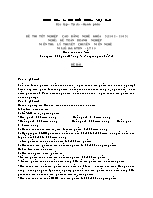 Đề và đáp án thi tốt nghiệp cao đẳng nghề khóa 5 - Nghề: Kế toán doanh nghiệp - Mã đề thi: KTDN - LT 10
Đề và đáp án thi tốt nghiệp cao đẳng nghề khóa 5 - Nghề: Kế toán doanh nghiệp - Mã đề thi: KTDN - LT 10ĐỀ BÀI Câu 1: (2 điểm) Thế nào là chi phí sản xuất kinh doanh và giá thành sản phẩm của doanh nghiệp? Trình bày cách phân loại chi phí sản xuất kinh doanh theo công dụng kinh tế và địa điểm phát sinh? Phân biệt chi phí sản xuất kinh doanh và giá thành sản phẩm của doanh nghiệp. Câu 2: (5 điểm) Doanh nghiệp An Bình có tình hình kinh doanh như sa...
 3 trang | Chia sẻ: nguyenlinh90 | Ngày: 19/07/2019 | Lượt xem: 1575 | Lượt tải: 4
3 trang | Chia sẻ: nguyenlinh90 | Ngày: 19/07/2019 | Lượt xem: 1575 | Lượt tải: 4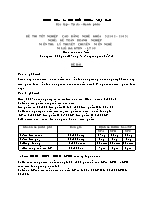 Đề và đáp án thi tốt nghiệp cao đẳng nghề khóa 5 - Nghề: Kế toán doanh nghiệp - Mã đề thi: KTDN - LT 09
Đề và đáp án thi tốt nghiệp cao đẳng nghề khóa 5 - Nghề: Kế toán doanh nghiệp - Mã đề thi: KTDN - LT 09ĐỀ BÀI Câu 1: ( 2 điểm) Trình bày khái niệm và đặc điểm của vốn lưu động trong doanh nghiệp? Trình bày cách phân loại vốn lưu động theo hình thái biểu hiện? Ý nghĩa của cách phân loại này. Câu 2: (5 điểm) Năm 2007 doanh nghiệp A có tài liệu như sau: (Đơn vị tính: 1.000đ) 1. Số dư sản phẩm đang chế tạo đầu năm: Sản phẩm A: 32.560; Sản phẩm B l...
 2 trang | Chia sẻ: nguyenlinh90 | Ngày: 19/07/2019 | Lượt xem: 1639 | Lượt tải: 3
2 trang | Chia sẻ: nguyenlinh90 | Ngày: 19/07/2019 | Lượt xem: 1639 | Lượt tải: 3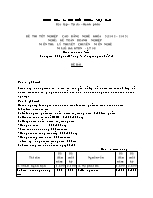 Đề và đáp án thi tốt nghiệp cao đẳng nghề khóa 5 - Nghề: Kế toán doanh nghiệp - Mã đề thi: KTDN - LT 08
Đề và đáp án thi tốt nghiệp cao đẳng nghề khóa 5 - Nghề: Kế toán doanh nghiệp - Mã đề thi: KTDN - LT 08ĐỀ BÀI Câu 1: ( 2 điểm) Trình bày những trình tự và căn cứ chủ yếu để lập kế hoạch tài chính? Lập kế hoạch tài chính có ý nghĩa như thế nào đối với hoạt động kinh doanh của doanh nghiệp. Câu 2: (5 điểm) Doanh nghiệp K chuyên kinh doanh một loại sản phẩm có tình hình như sau: I. Tài liệu năm báo cáo: 1. Số lượng sản phẩm sản xuất và tiêu thụ ...
 3 trang | Chia sẻ: nguyenlinh90 | Ngày: 19/07/2019 | Lượt xem: 1048 | Lượt tải: 2
3 trang | Chia sẻ: nguyenlinh90 | Ngày: 19/07/2019 | Lượt xem: 1048 | Lượt tải: 2 Đề và đáp án thi tốt nghiệp cao đẳng nghề khóa 5 - Nghề: Kế toán doanh nghiệp - Mã đề thi: KTDN - LT 07
Đề và đáp án thi tốt nghiệp cao đẳng nghề khóa 5 - Nghề: Kế toán doanh nghiệp - Mã đề thi: KTDN - LT 07ĐỀ BÀI Câu 1: ( 2 điểm) Thế nào là hao mòn và khấu hao tài sản cố định? Phân biệt khấu hao và hao mòn tài sản cố định? Trình bày nội dung cách tính khấu hao tài sản cố định bằng phương pháp khấu hao theo số dư giảm dần. Câu 2: (5 điểm) Công ty X chuyên sản xuất kinh doanh loại sản phẩm A có tài liệu như sau: I. Tài liệu năm báo cáo: 1. Tổng n...
 2 trang | Chia sẻ: nguyenlinh90 | Ngày: 19/07/2019 | Lượt xem: 1058 | Lượt tải: 2
2 trang | Chia sẻ: nguyenlinh90 | Ngày: 19/07/2019 | Lượt xem: 1058 | Lượt tải: 2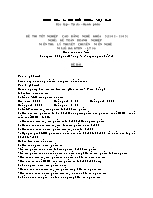 Đề và đáp án thi tốt nghiệp cao đẳng nghề khóa 5 - Nghề: Kế toán doanh nghiệp - Mã đề thi: KTDN - LT 06
Đề và đáp án thi tốt nghiệp cao đẳng nghề khóa 5 - Nghề: Kế toán doanh nghiệp - Mã đề thi: KTDN - LT 06ĐỀ BÀI Câu 1: ( 2 điểm) Trình bày nội dung, kết cấu bảng cân đối kế toán. Câu 2: (5 điểm) Doanh nghiệp F có các tài liệu sau: (Đơn vị tính: Triệu đồng) I. Tài liệu năm báo cáo: 1. Số dư VLĐ trong năm như sau: Đầu năm: 1200 ; Cuối quí 1: 1400; Cuối quí 2: 1500 Cuối quí 3: 1300; Cuối quí 4: 1400; 2. Số SP A tiêu thụ trong năm là 1.850 sản...
 2 trang | Chia sẻ: nguyenlinh90 | Ngày: 19/07/2019 | Lượt xem: 1041 | Lượt tải: 2
2 trang | Chia sẻ: nguyenlinh90 | Ngày: 19/07/2019 | Lượt xem: 1041 | Lượt tải: 2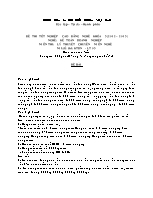 Đề và đáp án thi tốt nghiệp cao đẳng nghề khóa 5 - Nghề: Kế toán doanh nghiệp - Mã đề thi: KTDN - LT 05
Đề và đáp án thi tốt nghiệp cao đẳng nghề khóa 5 - Nghề: Kế toán doanh nghiệp - Mã đề thi: KTDN - LT 05ĐỀ BÀI Câu 1: (2 điểm) Trình bày khái niệm và đặc điểm của vốn lưu động? Phân biệt vốn cố định và vốn lưu động? Tính số vốn lưu động bình quân sử dụng trong năm và số ngày luân chuyển vốn lưu động trong năm N biết số liệu trong năm như sau: doanh thu thuần của doanh nghiệp đạt được là 360 triệu đồng, số vòng quay vốn lưu động là 3 vòng; số vốn lư...
 2 trang | Chia sẻ: nguyenlinh90 | Ngày: 19/07/2019 | Lượt xem: 1333 | Lượt tải: 2
2 trang | Chia sẻ: nguyenlinh90 | Ngày: 19/07/2019 | Lượt xem: 1333 | Lượt tải: 2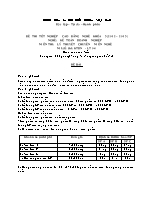 Đề và đáp án thi tốt nghiệp cao đẳng nghề khóa 5 - Nghề: Kế toán doanh nghiệp - Mã đề thi: KTDN - LT 04
Đề và đáp án thi tốt nghiệp cao đẳng nghề khóa 5 - Nghề: Kế toán doanh nghiệp - Mã đề thi: KTDN - LT 04ĐỀ BÀI Câu 1: (2 điểm) Trình bày khái niệm điểm hoà vốn. Viết và giải thích công thức tính sản lượng hoà vốn, doanh thu hoà vốn. Vẽ và mô tả đồ thị điểm hoà vốn. Câu 3: (5 điểm) Tại doanh nghiệp An Bình có số liệu sau: I. Tài liệu năm báo cáo: 1. Số lượng sản phẩm tồn kho đầu năm: 80 sản phẩm A; 100 SP B và 90 SP C 2. Số lượng SP sản xuất c...
 2 trang | Chia sẻ: nguyenlinh90 | Ngày: 19/07/2019 | Lượt xem: 1063 | Lượt tải: 2
2 trang | Chia sẻ: nguyenlinh90 | Ngày: 19/07/2019 | Lượt xem: 1063 | Lượt tải: 2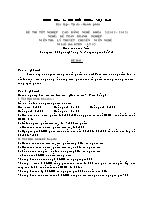 Đề và đáp án thi tốt nghiệp cao đẳng nghề khóa 5 - Nghề: Kế toán doanh nghiệp - Mã đề thi: KTDN - LT 03
Đề và đáp án thi tốt nghiệp cao đẳng nghề khóa 5 - Nghề: Kế toán doanh nghiệp - Mã đề thi: KTDN - LT 03ĐỀ BÀI Câu 1: (2 điểm) Trình bày những đặc trưng của cổ phiếu ưu đãi? Phân tích những điểm lợi và bất lợi của việc huy động vốn bằng cách phát hành cổ phiếu ra công chúng của các công ty cổ phần. Câu 2: (5 điểm) Doanh nghiệp F có các tài liệu sau : (Đơn vị tính : Triệu đồng) I. Tài liệu năm báo cáo : Số dư vốn lưu động trong năm như sau : Đầ...
 2 trang | Chia sẻ: nguyenlinh90 | Ngày: 19/07/2019 | Lượt xem: 1096 | Lượt tải: 2
2 trang | Chia sẻ: nguyenlinh90 | Ngày: 19/07/2019 | Lượt xem: 1096 | Lượt tải: 2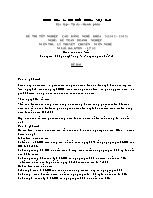 Đề và đáp án thi tốt nghiệp cao đẳng nghề khóa 5 - Nghề: Kế toán doanh nghiệp - Mã đề thi: KTDN - LT 02
Đề và đáp án thi tốt nghiệp cao đẳng nghề khóa 5 - Nghề: Kế toán doanh nghiệp - Mã đề thi: KTDN - LT 02ĐỀ BÀI Câu 1: ( 2 điểm) Trình bày khái niệm và giải thích công thức tính lãi đơn, lãi kép? Tính bài tập sau: Vào ngày 1/1, một công ty TNHH mua một ngôi nhà làm văn phòng giao dịch với giá 200 triệu đồng với sự thỏa thuận thanh toán như sau: - Trả ngay 10% số tiền - Số còn lại trả dần hàng năm bằng nhau trong 5 năm song phải chịu lãi 6% một năm...
 2 trang | Chia sẻ: nguyenlinh90 | Ngày: 19/07/2019 | Lượt xem: 957 | Lượt tải: 2
2 trang | Chia sẻ: nguyenlinh90 | Ngày: 19/07/2019 | Lượt xem: 957 | Lượt tải: 2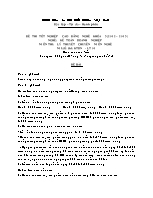 Đề và đáp án thi tốt nghiệp cao đẳng nghề khóa 5 - Nghề: Kế toán doanh nghiệp - Mã đề thi: KTDN - LT 01
Đề và đáp án thi tốt nghiệp cao đẳng nghề khóa 5 - Nghề: Kế toán doanh nghiệp - Mã đề thi: KTDN - LT 01ĐỀ BÀI Câu 1: (2 điểm) Trình bày nội dung và phương pháp tính thuế giá trị gia tăng. Câu 2: (5 điểm) Có tài liệu của doanh nghiệp sản xuất Hoàng Anh như sau: I. Tài liệu năm báo cáo: 1. Số dư vốn lưu động bình quân trong 3 quí như sau: Quí 1: 1200 triệu đồng Quí 2: 1310 triêụ đồng Quí 3: 1350 triệu đồng 2. Doanh thu tiêu thụ sản phẩm ở 3 qu...
 3 trang | Chia sẻ: nguyenlinh90 | Ngày: 19/07/2019 | Lượt xem: 1182 | Lượt tải: 2
3 trang | Chia sẻ: nguyenlinh90 | Ngày: 19/07/2019 | Lượt xem: 1182 | Lượt tải: 2
Website đang trong thời gian thử nghiệm, chờ xin giấy phép của Bộ TT & TT.

